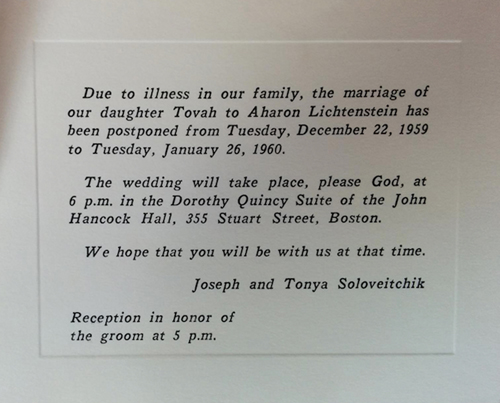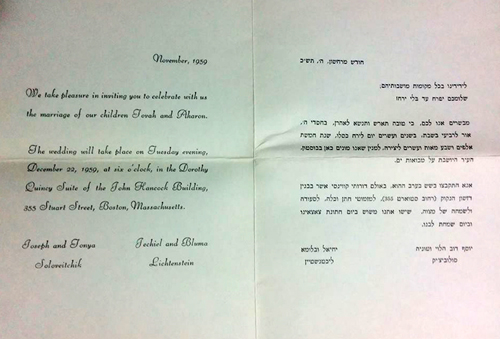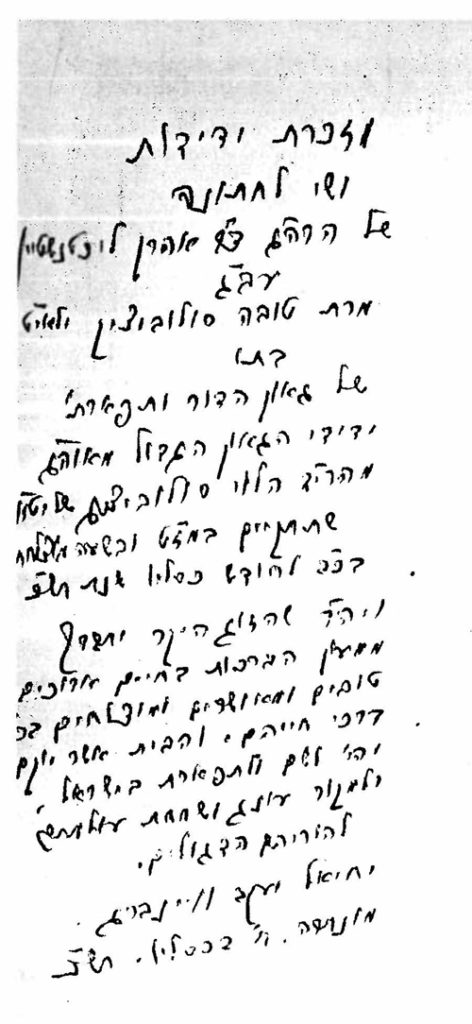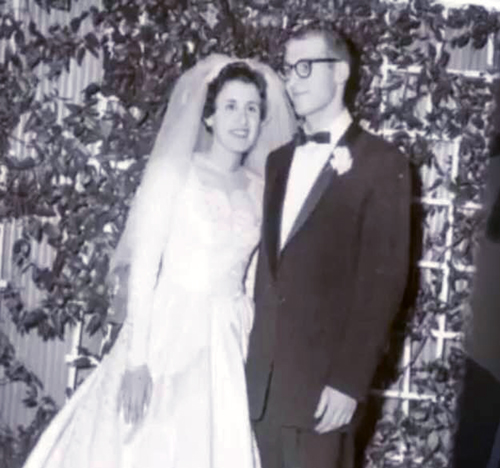[1]: א״ל הקב״ה … יודע אני כוונתו של אהרן היאך היתה לטובה On a Short Wedding Wish to the Lichtensteins from the Pen of Rabbi Jehiel Jacob Weinberg
Wish to the Lichtensteins from the Pen of Rabbi Jehiel Jacob Weinberg
In anticipation of the joyous occasion, to which he apparently could not arrive in person, Rav Weinberg sent an inscribed volume of Yad sha’ul,[26] a collection of essays compiled in memory of his beloved talmid muvhak (and the person primarily responsible for bringing him to Montreux in the first place),[27] Rabbi Saul Weingort (ca. 1914–1946),[28] who had passed away following a tragic train accident while on his way to deliver a shi‘ur at the yeshivah in Montreux.[29] Through some serendipitous twist of fate, it is this copy of the sefer which made its way into the open stacks of the Gottesman Library. The dedicatory text (see Fig. 2) and my translation thereof follow:
A gift and token of friendship presented on the occasion of the marriage of the ga’on, Rabbi Dr. Aharon Lichtenstein, to his soul mate, Ms. Tovah Soloveitchik[31] – may their years be long and good – the daughter of this generation’s pride and splendor, my friend, the great ga’on and Luminary of the Diaspora, our teacher, Rabbi Joseph B. ha-Levi Soloveitchik – may his years be long and good, amen – which is set to take place, under a lucky star and at an auspicious hour, on 22 Kislev [5]720. May it be His will that this precious couple be blessed from the Abode of Blessing with long, good, and joyous lives and with success in all of their endeavors. And may the home that they build be of fame and of glory in Israel [see I Chron. 22:5] and a source of eternal delight and happiness for their distinguished parents.
Jehiel Jacob Weinberg
Montreux, 8 Kislev [5]720 [December 9, 1959]
between Rabbis Weinberg and Soloveitchik, two leading rashei yeshivah whose formative years were spent in both the Lithuanian yeshivah world and the German academy. We know from other sources that they first met while the Rav was a student at the University of Berlin in the 1920s; according to testimony cited by Rabbi Aaron Rakeffet-Rothkoff, the Rav audited classes at Rav Weinberg’s Seminary during the 1926–1927 academic year.[33] Their encounters extended well beyond the classroom, however,[34] and even though Rav Weinberg was generally not enamored of the Brisker derekh ha-limmud espoused by Rav Soloveitchik and his forebears,[35] these two intellectual powerhouses maintained a deep appreciation for one another throughout their lives[36] – as can certainly be seen in Rav Weinberg’s above inscription.
The second issue that I wish to discuss here relates to the date of the wedding itself. As of 8 Kislev 5720, Rav Weinberg, quite justifiably, thought that it would take place two weeks hence. However, that very evening, December 9 – the same night the Rav delivered the aforementioned (n. 35) hesped for his uncle, Rabbi Isaac Ze’ev Soloveitchik (1886–1959) – Rav Soloveitchik “informed his family that he had been diagnosed with colon cancer, and would be returning to Boston the next day for surgery. His daughter Tovah and her fiancé R. Aharon Lichtenstein postponed their wedding (which had been set to take place in the coming days) until a few weeks later, so that the Rav could participate.”[37] Thus, the wedding was not actually held until Tuesday night, 27 Tevet 5720 (January 26, 1960) (see Figs. 3 and 4),[38] something Rav Weinberg could not have predicted at the time he penned his wishes to the young couple.
Looking back over
the past 50 years, what I am proudest of is what some would regard as being a
non-professional task. I’m proudest of having built, together with my wife, the
wonderful family that we have. It is a personal accomplishment, a social
accomplishment, and a contribution – through what they are giving and will
give, each in his or her own way – in service of the Ribbono shel Olam in the future.[42]
I wish at the outset to express my appreciation to yedidi, Reb Menachem Butler, ne‘im me’assefei yisra’el, for furnishing me with the opportunity, as well as many of the bibliographical sources (including the primary text itself!) required, to compose this essay. Additional thanks go to his fellow editors at the Seforim Blog for their consideration of this piece and, generally, for their great service to the public in maintaining such an active and high-quality platform for the serious discussion of topics of Jewish interest. Finally, I am indebted to my friends Eliyahu Krakowski, Daniel Tabak, and Shlomo Zuckier for their editorial corrections and comments to earlier drafts of this piece which, taken together, improved it considerably.
[1] See Shemot
rabbah (Vilna ed.) to Parashat
tetsavveh 37:2.
[4] One set of verses to which maspidim kept returning when describing
Rav Lichtenstein was those that appear in Malachi 2:5-7, together with the
rabbinic interpretation thereof: “If a given rabbi can be compared to an angel
of the Lord of Hosts, let them ask him to teach them Torah, and vice versa” (Hagigah 15b, Mo‘ed katan 17a). See the hespedim
of Rabbis Mayer Lichtenstein here
(listen at about 7:50), Mordechai Schnaidman here
(listen at about 23:00), and my friend Mordy Weisel here
(listen at about 5:05). Similarly, others have described him as angelic without
specific recourse to the verses in Malachi; see the hespedim of Rabbis Mosheh Lichtenstein here
(listen at about 9:25) and Avishai David here
(listen at about 1:03:25).
[5] So according to Rabbi Mordechai
Schnaidman here
(listen at about 16:00); see also Yosef Zvi Rimon, “Keitsad magdirim gedol dor?”
JobKatif (May 4, 2015). Similarly,
Rabbi Ari Kahn compared Rav Lichtenstein to Rabbi Israel Salanter (1810–1883) here
(listen at about 9:00 and 48:55), and Mrs. Esti Rosenberg said that the stories
people tell about her father remind her of those told about Rabbi Aryeh Levin
(1885–1969); see her interview with Yair Sheleg: “Yaledah ahat mul 700 otobusim,” Shabbat: musaf le-torah, hagut, sifrut
ve-omanut 927 (May 15, 2015).
[6] See her hesped here
(listen at about 0:35 and 2:25).
[7] See the hesped of Mrs. Tanya Mittleman, Rav Lichtenstein’s youngest, here
(listen at about 10:15).
[8] See the hesped of Rabbi Nathaniel Helfgot here
(listen at about 46:55).
[9] See the hesped of my friend David Pruwer here
(watch at about 18:50).
[10] See the hespedim of Rabbis Mosheh Lichtenstein here
(listen at about 4:50), Mayer Lichtenstein here
(listen at about 12:35), and Assaf Bednarsh here
(listen at about 14:05), as well as the video produced in honor of Rav
Lichtenstein’s eightieth birthday here (watch at about
9:25 and 11:35) and that of a public conversation between Rabbi Benny Lau and
Rav Aharon and Dr. Tovah Lichtenstein on the topic of “Education and Family in
the Modern World” held in Ra’anana on May 13, 2012 here (watch at about
27:45 and 28:55). See also the recently-released essay “On Raising Children,” The Israel Koschitzky Virtual Beit Midrash
(May 2015), based on a sihah
delivered by Rav Lichtenstein in July 2007.
[11] See the video produced in honor of Rav
Lichtenstein’s eightieth birthday here (watch at about
11:25), as well as the hesped of Mrs.
Tanya Mittleman here
(listen at about 19:05) and Mrs. Esti Rosenberg’s interview with Yair Sheleg, “Yaledah ahat mul 700 otobusim.”
[14] See the hesped of Rabbi Shay Lichtenstein here
(listen at about 23:00). See also the hesped
of David Pruwer here
(watch at about 18:45), as well as Rav Lichtenstein’s “On Raising Children.”
[16] See the hesped of Mrs. Tanya Mittleman here
(listen at about 19:10).
[17] Ibid. (listen at about 10:30).
[18] See his hesped here
(listen at about 16:50).
[20] Rabbi Assaf Bednarsh recounted here
that when Rav Lichtenstein would call his wife on the phone, he would address
her as “darling,” rather than “rebetsin” (listen at about 14:35). (Dr.
Lichtenstein herself reminisced here about how her
husband would sometimes jokingly address her as “Mrs. L.,” and she, in turn,
would call him “Reb Aharon” [watch at about 1:10]). Noach Lerman talked here
about how Rav Aharon would open the car door for his wife when they drove
somewhere (listen at about 34:25). Similarly, see the video here for a picture of
husband and wife going rafting together (watch at about 12:22) and, of course,
the dedication Rav Lichtenstein inscribed at the front of his two-volume Leaves of Faith (Jersey City, NJ: Ktav
Pub. House, 2003–2004): “To Tovah: With Appreciation and Admiration.”
toward the institutions of marriage and family and how they square with more
modern conceptions, see his “Ha-mishpahah ba-halakhah,” in Mishpehot beit yisra’el: ha-mishpahah bi-tefisat ha-yahadut
(Jerusalem: Misrad ha-Hinnukh ve-ha-Tarbut – Ha-Mahlakah le-Tarbut Toranit,
1976), 13-30, esp. pp. 21-30; “Of Marriage: Relationship
and Relations,” Tradition 39:2
(Summer 2005): 7-35, esp. pp. 10-13 (reprinted here
in Rivkah Blau, Gender Relationships in
Marriage and Out [New York: Michael Scharf Publication Trust of the Yeshiva
University Press; Jersey City, NJ: Ktav Pub. House, 2007], 1-34, and in Aharon
Lichtenstein, Varieties of Jewish
Experience [Jersey City, NJ: Ktav Pub. House, 2011], 1-37); and “On Raising Children.”
[21] In the course of the aforementioned (n.
10) public conversation on the topic of “Education and Family in the Modern
World” here, Dr. Lichtenstein
recalled that at the berit milah of
the couple’s firstborn son Mosheh, her father, Rabbi Joseph B. Soloveitchik
(1903–1993), sensing that Rav Lichtenstein harbored grand aspirations to save
the world, spoke about the importance of the father’s role in raising his
children and not leaving the job solely to his wife (watch at about 26:00). See
Rav Aharon’s parallel account in “On Raising Children,” as
well as his comment there that “I feel very strongly about the need for
personal attention in child-raising, and have tried to put it into practice.”
[23] Shlomo Zuckier and Shalom Carmy, “An Introductory
Biographical Sketch of R. Aharon Lichtenstein,” Tradition 47:4 (2015): 6-16, at p. 7. His dissertation would
eventually appear as Aharon Lichtenstein, Henry
More: The Rational Theology of a Cambridge Platonist (Cambridge, MA:
Harvard University Press, 1962).
[24] According to my friend Jonathan Ziring, in
an e-mail communication dated May 28, 2015, the Lichtensteins first met, by
chance, at the home of Rabbi Ahron Soloveichik (1917–2001), the Rav’s brother
and another major influence on Rav Lichtenstein. The Rav would later encourage
Rav Aharon to court his daughter, and the rest, as they say, is history.
[25] Image courtesy of Naftali Balanson’s Facebook page, as brought
to my attention by Rabbi Jeffrey Saks.
[26] Jehiel Jacob Weinberg and Pinchas Biberfeld (eds.), Yad
sha’ul: sefer zikkaron a[l] sh[em] ha-rav d”r sha’ul weingort zts”l (Tel Aviv: The
Widow of Saul Weingort, 1953).
[27] See Rav Weinberg’s memorial essay,
“Le-zikhro,” printed at the beginning of Yad
sha’ul, pp. 3-19, at p. 13.
[28] The date of Rabbi Weingort’s birth seems
somewhat controversial. Rav Weinberg himself, in “Le-zikhro,” 4,
estimates that his student was born in either 5673 or 5674 (1913 or 1914),
whereas the frontmatter
of the Yad sha’ul volume gives the
precise date 12 Kislev 5675 (November 30, 1914); Marc B. Shapiro, Between the Yeshiva World and Modern Orthodoxy: The Life and Works of
Rabbi Jehiel Jacob Weinberg, 1884–1966 (London; Portland, OR: Littman
Library of Jewish Civilization, 1999), 161, claims he was born in 1915; and the website of the Yad Shaoul
kolel in Kokhav Ya’akov, opened in
2011 and dedicated in Rabbi Weingort’s memory, concurs with Shapiro.
[29] See Weinberg, “Le-zikhro,” 15.
[30] Most readers are probably familiar with
the more common Hebrew spelling of “Soloveitchik” with a final kof. Rav Weinberg, however, generally
preferred ending the name in a gimel
(except, strangely, in the case of the Rav’s daughter Tovah).
[31] Dr. Lichtenstein would go on to complete
her doctoral studies in social work at Bar-Ilan University following the
family’s arrival in Israel in 1971, writing her dissertation on “Genealogical
Bewilderment and Search Behavior: A Study of Adult Adoptees Who Search for
their Birth Parents” (1992). She is therefore referred to here without her
doctoral title.
[32] It should be noted that Rav Lichtenstein
served as coeditor of the rabbinic periodical Hadorom during the mid-1960s and, as such, may have been involved
in editing some of Rav Weinberg’s last publications to appear during his
lifetime. (For a partial bibliography of Rav Weinberg’s oeuvre, see Michael
Brocke and Julius Carlebach, Biographisches
Handbuch der Rabbiner: Teil 2: Rabbiner im Deutschen Reich, 1871–1945, vol.
2 [Munich: K. G. Saur, 2009], 639-640 [no. 2657]. For a fuller inventory, see Shapiro,
Between the Yeshiva World and Modern Orthodoxy, 239-246.) Discovery and analysis of any
potential remaining correspondence between the two during this period remain
scholarly desiderata.
[33] See Aaron Rakeffet-Rothkoff, The Rav: The World of Rabbi Joseph B.
Soloveitchik, ed. Joseph Epstein, vol. 1 (Hoboken, NJ: Ktav Pub. House,
1999), 27 with n. 13. Similarly, see Shalom Carmy, “R. Yehiel Weinberg’s Lecture on Academic Jewish
Scholarship,” Tradition
24:4 (Summer 1989): 15-23, at p. 16.
[34] See Werner Silberstein, My Way from Berlin to Jerusalem, trans.
Batya Rabin (Jerusalem: Special Family Edition Published in Honor of the Author’s 95th
Birthday, 1994), 26-27, as quoted in Aaron Rakeffet-Rothkoff, “Rabbi Joseph B. Soloveitchik: The Early Years,” Tradition 30:4 (Summer 1996): 193-209,
at p. 197; idem, The Rav, 28; and idem, From
Washington Avenue to Washington Street (Jerusalem; Lynbrook, NY: Gefen; New
York: OU Press, 2011), 108 (available here).
[35] See his letter to Rabbi Jacob Arieli of
Jerusalem composed sometime after 2 Nisan 5711 (April 8, 1951), as reproduced
in Jehiel Jacob Weinberg, Seridei esh:
she’elot u-teshuvot hiddushim u-bei’urim be-dinei orah hayyim ve-yoreh de‘ah, vol. 2 (Jerusalem:
Mossad Harav Kook, 2003), 355-357 (sec. 144), at pp. 356-357; his letters to Dr. Gabriel Hayyim Cohn,
dated 27
Tevet 5725 (January 1, 1965) and 19 Kislev 5726 (December 13, 1965), as
reproduced in Jehiel Jacob Weinberg, Kitvei
ha-ga’on rabbi yehiʼel yaʻakov weinberg, zts”l, ed. Marc B. Shapiro, vol. 2
(Scranton, PA: Marc B. Shapiro, 2003), 219 n. 4 (esp. the latter one); and the
beginning of the selection from his eulogy for Rabbi Weingort printed in Yad sha’ul, 16. For a partial translation of the Rav’s famous hesped “Mah dodekh mi-dod,” which
originally appeared in Hebrew in Hadoar
43:39 (September 27, 1963): 752-759 and is referred to by Rav Weinberg in the
last letter cited above, see Jeffrey Saks, “Rabbi Joseph B. Soloveitchik on the Brisker Method,” Tradition 33:2 (Winter 1999): 50-60.
Judith Bleich, “Between East and West: Modernity and
Traditionalism in the Writings of Rabbi Yehi’el Ya’akov Weinberg,” in Moshe Z. Sokol
(ed.), Engaging Modernity: Rabbinic
Leaders and the Challenge of the Twentieth Century (Northvale, NJ;
Jerusalem: Jason Aronson Inc., 1997), 169-273, at p. 239; Marc B. Shapiro, “The Brisker Method Reconsidered,” Tradition 31:3 (Spring 1997): 78-102, at
p. 86, with n. 25; idem, Between the
Yeshiva World and Modern Orthodoxy, 194-195, with nn. 95-98; and Nathan
Kamenetsky, Making of a Godol: A Study of
Episodes in the Lives of Great Torah Personalities, vol. 1, 1st
ed. (Jerusalem: Hamesorah, 2002), 432-433. See also Rabbi Eliezer Berkovits’
assessment of his teacher’s derekh
ha-limmud in “Rabbi Yechiel Yakob Weinberg zatsa”l: My Teacher and Master,” Tradition 8:2 (Summer 1966): 5-14, at
pp. 5-10. For Rav Lichtenstein’s own reflections on the types of criticisms of
the Brisker derekh expressed by Rav
Weinberg, see his “Torat Hesed and Torat Emet: Methodological Reflections,”
in idem, Leaves of Faith, 1:61-87,
esp. at pp. 78-83, as well as an earlier version of this essay cited in
Shapiro, “The Brisker Method Reconsidered,” 93-94. (I am indebted
to Eliyahu Krakowski for bringing the Kamenetsky and Lichtenstein references to
my attention.) See also Aharon Lichtenstein, “The Conceptual Approach to Torah
Learning: The Method and Its Prospects,” in idem, Leaves of Faith, 1:19-60, esp. at pp. 43-44, 48-50.
“Rabbi Moses Soloveitchik” in Rav Weinberg’s published works, excluding those made
in the above letters, generally refer not to the Rav’s father (1879–1941) but
to his Swiss first cousin (1915–1995), son of Rabbi Israel Gerson Soloveitchik
(1875–1941), son of Rabbi Hayyim Soloveitchik (1853–1918).
[36] Indeed, Rav Weinberg would consistently
refer to the Rav in writing by his honorific rabbinic handle, “Ha-g[a’on]
r[abbi] y[osef] d[ov],” or a variant thereof (as in our case); see his Seridei esh, 2:196-201 (sec. 78),
at p. 198 (dated 29 Adar 5716 [March 12, 1956]), and idem, Kitvei ha-ga’on rabbi yehiʼel yaʻakov weinberg, zts”l, 219 n. 4. According to Shapiro, Between the Yeshiva World and Modern
Orthodoxy, 163, Rav Weinberg also contacted the Rav after the War to seek
his assistance during his long recovery.
record with which I am familiar is a bit more reticent, although Rabbi Howard
Jachter reports the following in the context of a discussion of the prohibition
of kol ishah and Rav Weinberg’s
now-famous lenient ruling on the question:
asked Rav Yosef Dov Soloveitchik in July 1985 whether he agrees with this
ruling of Rav Weinberg. The Rav replied, “I agree with everything that he
wrote, except for his permission to stun animals before Shechita” (see volume
one of Teshuvot Seridei Eish). Rav Soloveitchik related his great appreciation
of Rav Yechiel Yaakov Weinberg. Rav Shalom Carmy later told me that Rav
Soloveitchik and Rav Weinberg had been close friends during the years that Rav
Soloveitchik studied in Berlin.
Literature (New York: Ktav Publishing House, Inc., 1977), 183-189; Bleich,
“Between East and West,” 260-261, 271-272;
and Shapiro, Between the Yeshiva World
and Modern Orthodoxy, 117-129, 192. For Rav Soloveitchik’s own involvement
in questions relating to the humane slaughter of animals, see Joseph B.
Soloveitchik, Community, Covenant and
Commitment: Selected Letters and Communications, ed. Nathaniel Helfgot
(Jersey City, NJ: Toras HoRav Foundation, 2005), 61-67.
[37] Jeffrey Saks, “Rabbi Joseph B. Soloveitchik and the Israeli Chief
Rabbinate: Biographical Notes (1959–60),” BDD 17 (September 2006): 45-67, at p.
53.
[38] Fig. 3 is courtesy of Naftali Balanson’s
Facebook page, as
brought to my attention by Rabbi Jeffrey Saks. Fig. 4 derives from the video
produced in honor of Rav Lichtenstein’s eightieth birthday here (watch at about
1:03). (I am indebted to Rabbis Dov Karoll, Jeffrey Saks, and Reuven Ziegler
for confirming some of the details of the Lichtenstein wedding for me.)
[39] See the interview with Rabbi Dov Karoll
on Voice of Israel here
(listen at about 2:55). See also the hesped
of Rabbi Mosheh Lichtenstein here
(listen at about 5:15). Similarly, at a sheloshim
event held at the Hechal Shlomo Jewish Heritage Center in Jerusalem on May 18,
Mrs. Esti
Rosenberg, in speaking of her father’s self-identification with the Levites as
the prime exemplars of ovedei Hashem par excellence, commented that just as the
Levites were netunim netunim to Aaron
and his sons in Parashat be-midbar (Num.
3:9) (which also happened to be Rav Lichtenstein’s bar mitzvah parashah), so was Rav Aharon completely
dedicated to his family. See the video here (watch at about 11:40). And for a
visual representation of just how central avodat
Hashem was to Rav Lichtenstein’s core identity, see the photograph of his matsevah posted to Yeshivat Har Etzion’s
Facebook page.
[40] From a forthcoming article to be published
in Jewish Action.
[41] See his hesped here
(listen at about 10:30).
[42] See Rav Lichtenstein’s interview with
Yaffi Spodek: “Reflecting
on 50 Years of Torah Leadership,” the
YUNews blog (October 11, 2011). Similarly, see this video produced in honor
of Rav Lichtenstein receiving the Israel Prize in 2014 (watch at about 10:20),
as well as the hespedim of Mrs. Esti
Rosenberg here
(listen
at about 8:45) and Rabbi Baruch Gigi here (listen at about 16:30) and the
former’s interview with Yair Sheleg, “Yaledah ahat mul 700 otobusim.” Finally, see Rav Lichtenstein’s sihah “On Raising Children,” where
he states unequivocally: “There are very few people about whom it can […]
genuinely be said that there is something objectively more important in their
life than raising children.”


